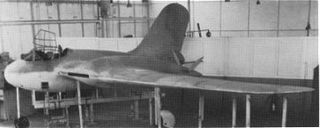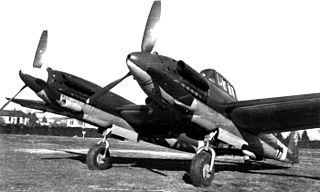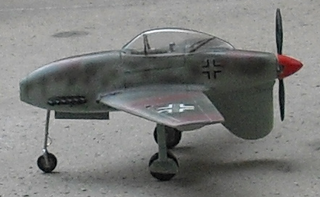| Me 509 | |
|---|---|
 | |
| Model picture Me 509 | |
| Role | Fighter aircraft |
| Manufacturer | Messerschmitt |
| Status | Unrealised project |
The Messerschmitt Me 509 was an all-metal fighter project, underway in Germany during World War II.
| Me 509 | |
|---|---|
 | |
| Model picture Me 509 | |
| Role | Fighter aircraft |
| Manufacturer | Messerschmitt |
| Status | Unrealised project |
The Messerschmitt Me 509 was an all-metal fighter project, underway in Germany during World War II.
Not much information about this project has survived. It was based on the Me 309 but with the engine located behind a pressurized cockpit, much in a similar manner to the US Bell P-39 Airacobra.
The engine was a Daimler-Benz DB 605B driving a three-blade propeller, and armament was to consist of two 13 mm (.51 in) MG 131 machine guns and two 20 mm MG 151/20 cannon. The tricycle landing gear from the Me 309 was retained, which worked better on the 509, due to the lower weight on the nosewheel - the Me 309's nosegear had collapsed during trials. The smaller nose would have improved visibility. The project was cancelled along with the Me 309, [1] but the Japanese made a similar aircraft, the Yokosuka R2Y Keiun, which suffered from engine overheating. [2]
Data from[ citation needed ]
General characteristics
Performance
Armament
Related development
Aircraft of comparable role, configuration, and era

The Messerschmitt Me 210 was a German heavy fighter and ground-attack aircraft of World War II. Design started before the war, as a replacement for the Bf 110. The first examples were ready in 1939, but they proved to have unacceptably poor flight characteristics due to serious wing planform and fuselage design flaws. A large-scale operational testing program throughout 1941 and early 1942 did not cure the type's problems. The design entered limited service in 1942, but was soon replaced by the Messerschmitt Me 410 Hornisse, a further development of the Me 210. The failure of the Me 210's development program meant the Luftwaffe was forced to continue operating the Bf 110 after it had become outdated, despite mounting losses.

The Messerschmitt Me 410 Hornisse (Hornet) is a German heavy fighter and Schnellbomber used by the Luftwaffe during World War II. Though an incremental improvement of the Me 210, it had a new wing plan, longer fuselage and engines of greater power. The changes were significant enough for the aircraft to be renamed the Me 410.

The Blohm & Voss BV 155 was a German high-altitude interceptor aircraft intended to be used by the Luftwaffe against raids by USAAF Boeing B-29 Superfortresses. Work started on the design as the Messerschmitt Me 155 in 1942, but the project went through a protracted development period and change of ownership, and prototypes were still under test and development when World War II ended.

The Messerschmitt Bf 110, often known unofficially as the Me 110, is a twin-engine Zerstörer, fighter-bomber, and night fighter (Nachtjäger) developed in Nazi Germany in the 1930s and used by the Luftwaffe during World War II. Hermann Göring was a proponent of the Bf 110, believing its heavy armament, speed, and range would make the Bf 110 the Luftwaffe’s premier offensive fighter. Early variants were armed with two MG FF 20 mm cannon, four 7.92 mm MG 17 machine guns, and one 7.92 mm MG 15 machine gun for defence. Development work on an improved type to replace the Bf 110 - the Messerschmitt Me 210 - began before the war started, but its teething troubles resulted in the Bf 110 soldiering on until the end of the war in various roles. Its intended replacements, the aforementioned Me 210 and the significantly improved Me 410 Hornisse never fully replaced the Bf 110.

The Avia S-199 is a propeller-driven Messerschmitt Bf 109G-based fighter aircraft built after World War II utilizing the Bf 109G airframe and a Junkers Jumo 211F engine in place of the original and unavailable Daimler-Benz DB 605 engine. It is notable as the first fighter obtained by the Israeli Air Force, and used during the 1948 Arab-Israeli War.

The Arado Ar 240 was a German twin-engine, multi-role heavy fighter aircraft, developed for the Luftwaffe during World War II by Arado Flugzeugwerke. Its first flight was in 1940, but problems with the design hampered development, and it remained only marginally stable throughout the prototype phase. The project was eventually cancelled, with the existing airframes used for a variety of test purposes.

The Focke-Wulf Fw 191 was a prototype German bomber of World War II, as the Focke-Wulf firm's entry for the Bomber B advanced medium bomber design competition. Two versions were intended to be produced, a twin-engine version using the Junkers Jumo 222 engine and a four-engine variant which was to have used the smaller Daimler-Benz DB 605 engine. The project was eventually abandoned due to technical difficulties with the engines.

The Me 209 of 1943 was an attempt to create an enhanced version of the Bf 109, which served as the Luftwaffe's primary fighter aircraft throughout World War II. The Me 209, despite its designation, bore no relationship to the earlier Me 209.

The Messerschmitt Me 309 was a prototype German fighter, designed in the early years of World War II to replace the Bf 109. Although it had many advanced features, the Me 309's performance left much to be desired and it had so many problems that the project was cancelled with only four prototypes built. The Me 309 was one of two failed Messerschmitt projects intended to replace the aging Bf 109, the other being the Me 209 of 1943.

The Messerschmitt Me 609 was a World War II German project which joined two fuselages of the Me 309 fighter prototype together to form a heavy fighter.

The Arado Ar 197 was a German World War II-era biplane, designed for naval operations for the never-completed German aircraft carrier Graf Zeppelin. Only a few prototypes were built; the project was abandoned in favour of the Messerschmitt Bf 109T and Me 155.
The Messerschmitt Me 265 was a design project for a Zerstörer, produced by leading German aircraft manufacturer Messerschmitt in World War II.

The Messerschmitt Me 329 was a design project for a heavy fighter and ground-attack aircraft, developed towards the end of World War II. It was a competitor and possible successor to the Me 410. Like the Me 265, the Me 329 used an advanced flying wing design. Other advanced features included the pilot and navigator sitting side by side in a broad bubble canopy, and a remote-controlled rear gun in the tail. In spite of the futuristic design, the improvement in performance over the Me 410 was marginal. Development received a low priority, and while a full-scale glider was tested at Rechlin in the winter of 1944/5, work on the project was cancelled shortly after.

The Heinkel He 119 was an experimental single-propeller monoplane with two coupled engines, developed in Germany. A private venture by Heinkel to test radical ideas by the Günter brothers, the He 119 was originally intended to act as an unarmed reconnaissance bomber capable of eluding all fighters due to its high performance.
The Messerschmitt Me 310 was a prototype German heavy fighter of World War II. It was a project to save the aerodynamically troubled Me 210.

The Savoia-Marchetti SM.91 was a two-seat, twin-engined, Italian heavy fighter prototype, designed to compete in a 1942 revision to a long-range fighter-bomber contract offered by the Regia Aeronautica to Italian aircraft companies in 1938. The original 1938 specification yielded the Savoia-Marchetti SM.88, which the SM.91 was largely based on.

The Savoia-Marchetti SM.92 was an Italian heavy fighter/bomber of World War II based on the Savoia-Marchetti SM.88. The SM.92 did away with the mid-wing crew nacelle. The crew of two sat in the left fuselage only. Two DB 605 engines were fitted.

Due to the Messerschmitt Bf 109's versatility and time in service with the German and foreign air forces, numerous variants were produced in Germany to serve for over eight years with the Luftwaffe. Additional variants were produced abroad totalling in 34,852 Bf 109s built.

The IMAM Ro.58 was an Italian twin-engined, two-seat monoplane heavy fighter and attack aircraft, a development of the IMAM Ro.57. First flown in May 1942, it was considered a general improvement over its predecessor, mainly due to the substitution of higher power Daimler-Benz DB 601 engines for the Fiat A.74 engines used on the Ro.57. Initially it had many problems and during the maiden flight only the proficiency of the test pilot, Adriano Mantelli, saved the plane.

The Messerschmitt Me 334 was a proposed German piston-engined fighter, designed by Alexander Lippisch. No examples were built.